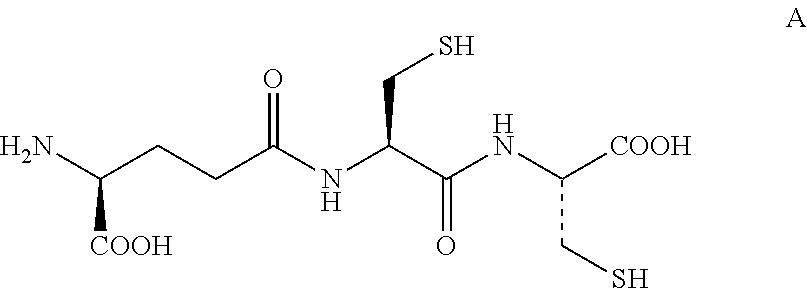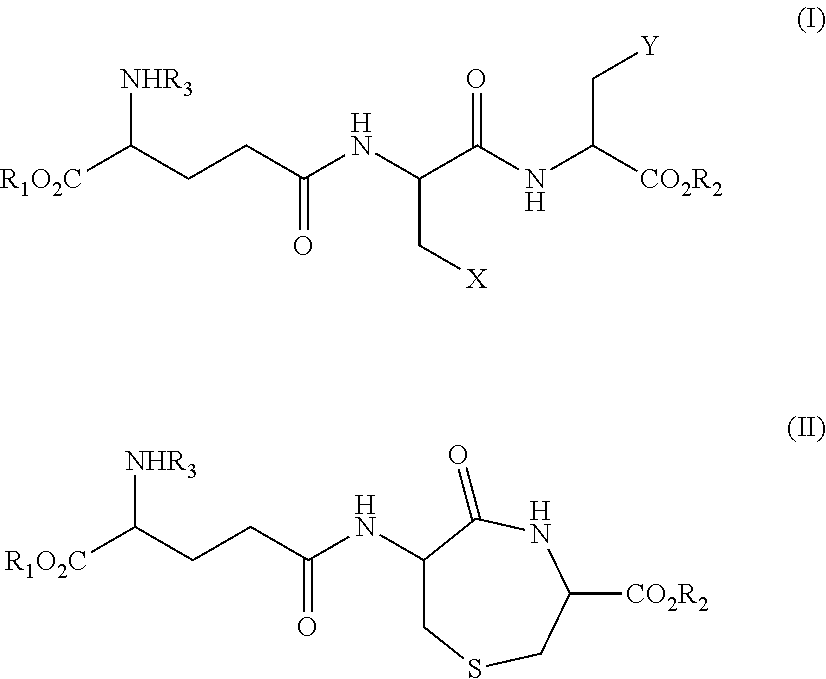Method for Producing Lanthionine Derivative
a technology of lanthionine and derivative, which is applied in the direction of peptides, food preparations, drug compositions, etc., can solve the problems of stability and odor, and achieve the effects of favorable food and/or beverage, high casr agonist activity, and excellent kokumi-imparting
- Summary
- Abstract
- Description
- Claims
- Application Information
AI Technical Summary
Benefits of technology
Problems solved by technology
Method used
Image
Examples
example 1
Synthesis (1) of Compound Represented by Formula (III) (Compound Represented by Formula (II) where R1, R2, and R3 are all Hydrogen) Using Compound Represented by Formula VI
[0130]γ-Glu-Cys-Cys(VI) synthesized with reference to Non Patent Literature 2 was dissolved in ultra pure water to prepare a pH 3.3 aqueous sample solution of a concentration of 53 ppm. A portion of the pH 3.3 aqueous sample solution was taken out, and the pH was adjusted to 10 by adding an aqueous sodium hydroxide solution. Then, 100 μL of the solution was dispensed to a 1.5 mL micro test tube. The dispensed aqueous solution was heated for 6 hours with a water bath at 90° C.
[0131]The obtained heat-treated sample was subjected to separation by reverse-phase liquid chromatography shown below, and introduced into a mass spectrometer to quantify the amount of the compound represented by formula (III) contained in the sample. As a standard for the quantification, the compound represented by formula (III) and synthesiz...
example 2
Synthesis (2) of Compound Represented by Formula (III) (Compound Represented by Formula (II) where R1, R2, and R3 are all Hydrogen) Using Compound Represented by Formula VI
[0147]The pH 3.3 aqueous sample solution (8 mL) prepared in Example 1 was adjusted to 12 by adding an aqueous sodium hydroxide solution, and then 100 μL of the solution was dispensed to a 1.5 mL micro test tube. Then, the sample heat-treated for 6 hours was prepared by the same method as in Example 1, and then the amount of Compound III was quantified.
[0148]Yield
[0149]The reaction yields were as follows.
TABLE 1Yield (%)Example 110.4Example 213.0
example 3
Synthesis (3) of Compound Represented by Formula (III) (Compound Represented by Formula (II) where R1, R2, and R3 are all Hydrogen) Using Compound Represented by Formula VI
[0150]γ-Glu-Cys-Cys(VI) was dissolved in ultra pure water to prepare a pH 3.3 aqueous sample solution of a concentration of 0.3 mM (106 ppm). To the pH 3.3 aqueous sample solution (0.5 mL), a 200 ppm aqueous iron(III) nitrate solution (0.5 mL) was added, and then the pH was adjusted to 10 with an aqueous sodium hydroxide solution. This aqueous solution was further heated for 5 hours with a water bath at 90° C. The amount of Compound III in this heat-treated sample was quantified.
PUM
| Property | Measurement | Unit |
|---|---|---|
| temperature | aaaaa | aaaaa |
| temperature | aaaaa | aaaaa |
| temperature | aaaaa | aaaaa |
Abstract
Description
Claims
Application Information
 Login to View More
Login to View More - R&D
- Intellectual Property
- Life Sciences
- Materials
- Tech Scout
- Unparalleled Data Quality
- Higher Quality Content
- 60% Fewer Hallucinations
Browse by: Latest US Patents, China's latest patents, Technical Efficacy Thesaurus, Application Domain, Technology Topic, Popular Technical Reports.
© 2025 PatSnap. All rights reserved.Legal|Privacy policy|Modern Slavery Act Transparency Statement|Sitemap|About US| Contact US: help@patsnap.com



